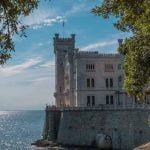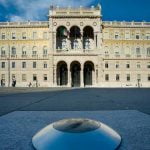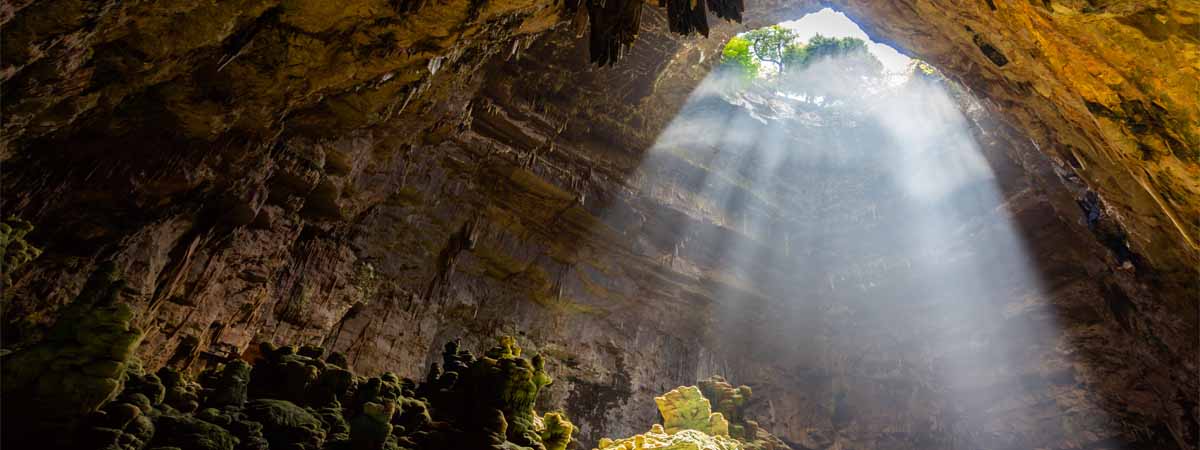Trieste, the regional capital of Friuli Venezia Giulia, is an attractive city located in the innermost part of the homonymous gulf of the northern Adriatic Sea. It amphitheatrically extends along the coastline and on the karst relief of the slopes flanking the sea.
Offering magnificent views over the surrounding landscape, the city occupies the northwestern slope of the San Giusto Hill and has been an important trade hub since antiquity.
During the Middle Ages, the settlement developed into a modest urban area, and for centuries various peoples struggled and fought for supremacy.
A first significant expansion in the area occurred in the eighteenth century, driven by the imperial government of Austria in an attempt to strengthen its economic activities.
With the extension of the city beyond the ancient inhabited center, Trieste gained its chessboard appearance characterized by long straight streets and orthogonal squares. Moreover, the city also developed a new district and port facilities.
A bishopric center and university seat, Trieste also boasts a long and rich history characterized by the passage of numerous civilizations.
PREHISTORY OF TRIESTE
Trieste has a millennial history and a troubled existence, continually contended between multiple factions. The current territory of
Trieste and Istria have been inhabited since the prehistoric Bronze Age.
Since the second millennium BC, the entire territory of Trieste and its province was the site of important proto-historic settlements. It is believed that the first culture to settle in the region was the Castellieri, an Illyrian ethnic group renowned for their perched villages protected by stone fortifications.
Between the tenth and ninth centuries BC, the native populations came into contact with another Indo-European group, the Venetians; the two peoples merged, greatly influencing one another from a cultural standpoint.
Historians even claim the name of the city would have pre-roman origins of an Indo-European base. The original name of the city, Tergeste, could have, in fact, derived from the term terg, meaning market, to which was added the suffix este, typical to the toponyms of the Veneto region.
If that were to be the true meaning of Trieste, the city’s ancient name already denotes the massive commercial importance the settlement had since the earliest times.
With the Roman conquest of Illyria, whose most salient episodes were the war against the Istrian pirates in 221 BC, but also the foundation of Aquileia and the Istrian War, there began a true process of Romanization and assimilation of the pre-existing populations, including those settled in Trieste.
The settlement became part of the Venetia et Histria region under the administrative rule of Aquileia.
Trieste was colonized in the middle of the first century BC by Caesar. The Romans built a true fortress on the slopes of the San Giusto Hill. This colony soon became an important military outpost and commercial hub with the main function of protecting the Roman colonies from the barbarian incursions.
Due to its military and commercial importance, Trieste developed and prospered in the Imperial era, establishing itself as one of the most important ports in the upper Adriatic and a key transition point on Via Popilia-Annia.
In 33 BC, the residential nucleus gained imposing city walls, some of which are still visible at the southern gate of the city, the so-called Arch of Richard. At the same time, Octavius Augustus also enriched the municipality with a forum and a theater. However, this prosperous period was bound to come to an end with the disintegration of the Roman Empire.
HISTORY OF TRIESTE
After the fall of the Western Roman Empire, the city passed under Byzantine rule until 788 when it was occupied by the Franks.
The city played an important role in the development of early Christianity, and in 1098, it became a diocese ruled by bishops.
However, the church did not establish its hegemony in the region, and the city became a free municipality in the twelfth century.
What followed was a century of fierce battles against Venice that concluded with the placement of Trieste under Austrian protection in 1382.
From then on, Trieste’s history followed the history of Austria until the eighteenth century, managing to retain a considerable autonomy over the decades.
At the beginning of the eighteenth century, Austria’s expansion ambitions brought Trieste into the spotlight for the first time. The city became the only outlet on the Adriatic Sea of the Austrian Empire, as well as a free port.
During those years, the city was subject to massive investments and knew a fast development that gained it the title of the regional capital of the Adriatic Coast of the Empire. But despite its privileged status, the city always maintained its cultural links with Italy.
In fact, even if the official language was now German all over Istria’s territory, the Italian language was still present in trade and culture.
These untouched cultural roots gave rise to the irredentism in Trieste, a movement born in the last decades of the nineteenth century with the aim to annex the city to Italy. Above all, a rising bourgeois class, including the wealthy Jewish colony, fueled by the irredentism, whose political aspirations did not fit those of the Austro-Hungarian Empire, started to revolt and push for annexation.
Unhappy with the events, Emperor Franz Joseph ordered a policy of “Germanization” of the Italians living in the Friuli Venezia Giulia region. Among the many measures adopted, the Habsburg administration ordered mass expulsions imposed by the governor of Trieste, the prince of Hohenlohe.
This caused the forced deployment of over 35,000 Italians at the beginning of the twentieth century.
In 1913, following another decree of the prince, the nationalist Slavic supporters of the empire held a public rally against Italy, with demonstrations against the country and the Italians.
Besides these events, there were also many other discriminatory initiatives against the Italians, including episodes of violence with many victims.
At the same time, the empire engaged in spreading the Austrian culture in schools and institutions by imposing German as the primary language, along with Slovenian and Croatian. Other measures included cutting funds to the Italian schools and banning their restructuration in a clear attempt to eliminate the Italian culture and history, just as it happened in Dalmatia.
This cultural war also brought strict forms of censorship which included studying Italian literature on texts translated in German, or the prohibition of studying the history of Trieste because it was too “Italian.”
Due to these events, the autonomy of Trieste came to be drastically reduced by the centralism of Vienna.
In fact, the Austrian government did everything in its power to weaken the political and economic power of Trieste, a city controlled up to this point by the national-liberal Italians. Yet, Austria did not consider the close political, cultural, and social relations the political parties in Trieste had with their Italian counterparts.
In the intricate course of the events and following the expulsions, Trieste found itself inhabited by a majorly Slovenian population which was in full demographic, social and economic growth according to the controversial census of 1910.
The cohabitation between the various ethnic groups that had for centuries distinguished the social reality of Trieste and Gorizia, therefore, suffered a general deterioration in the years preceding World War I.
In light of these events, it is clear why the arrival of the Royal Army in Trieste in 1918 was acclaimed by the majority of the inhabitants, who still had Italian sentiments. The imminent annexation of the city and of Venezia Giulia to Italy was accompanied by a further decay of the relations between the Italian and the Slovenian ethnic groups, sometimes translated into armed clashes.
Riots broke out in Trieste on April 13, 1920, following an attack against the Italian army stationed in Split, Croatia. During the unrest, marked by a strong anti-Slavic character, a group of squads from Trieste presided over the Balkan Hotel which was the cultural center of the Slovenes, setting it on fire.
Following the Treaty of Rapallo in November 1920, Trieste was definitively annexed to Italy together with its provincial territory, namely the areas of the former county of Gorizia and Gradisca, Istria, and Carniola.
The period between the two World Wars was marked by numerous difficulties, especially from an economic point of view. The city was hit by the loss of its centuries-old economic hinterland with subsequent consequences for the port and commercial activity.
Trieste lost its traditional municipal autonomy, while its linguistic and cultural configuration also suffered numerous changes.
In fact, the city witnessed a massive emigration of the entire German-speaking community. With the advent of fascism, the public use of languages other than Italian was forbidden in schools, cultural clubs, and in the press, while all press addressing the Slovenian community was closed.
This caused a massive emigration of the Slovenian population too, who settled in the nearby Kingdom of Yugoslavia. Nevertheless, immigration movements from Dalmatia helped Trieste maintain the number of its population.
However, neighboring Slovenia and Croatia did not sit and watch. With the advent of many anti-fascist organizations, they succeeded in bombing the city center and a few areas on the outskirts.
But despite the economic problems and tense political climate, the population of the city grew during the second decade of the twentieth century, thanks in part to immigration from other areas of Italy.
The inter-war period was characterized by an unusual quietness and important urban restructuring, including the construction of new buildings such as the University and the Victory Lighthouse.
As it happened in many other places in Europe, World War II deeply marked the history of Trieste and the surrounding region. In September 1943, Nazi Germany occupied Trieste and Venice and transformed them into a zone of war operations.
The administration of the city fell into the hands of the fascists responding directly to Mussolini. However, during the Nazi occupation, the city received its National Monument and a prison, Risiera of San Sabba – now converted into a museum – destined to the displacement of deportees to Germany and Poland and for political prisoners or partisans.
Trieste’s Risiera of San Sabba was not only a place of detention though. Equipped with a crematorium, the place served as an extermination camp as well, the only one in Italy.
At the end of the war, the Yugoslavian partisan brigades assumed control of the city, while the allies recognized that the liberation was accomplished by Tito’s partisans. In exchange, Yugoslavia obtained direct management of the port and of communication routes with Austria.
This led once again to the suppression of all Italians living in Trieste, who were arrested and used for forced labor.
On May 8, 1945, Trieste was proclaimed an autonomous city within the Federative Republic of Yugoslavia. In the middle of these difficult times, the people of Trieste still struggled between deeply different ideas, the annexation to Yugoslavia, or the return to Italy.
After two years of uncertainty and after hearing both the Yugoslav and the Italian claims, the UN established the Free Territory of Trieste. However, due to the impossibility to name a governor, the territory remained divided into two zones of military occupation, administered by the Anglo-Americans and the Yugoslavs.
What followed was years of struggles, but in October 1954, the Free Territory of Trieste was finally divided between Yugoslavia and Italy.
In 1962, on this uncertain background, Trieste became the capital of the Autonomous Region of Friuli Venezia Giulia, and in 1975, after the Treaty of Osimo, the entire territory of the city passed under Italian rule.
ARCHAEOLOGY IN TRIESTE
Trieste holds rich archaeological evidence, especially of its Roman past. A noteworthy open-air site located in the heart of the city is the Roman amphitheater situated at the foot of the San Giusto Hill. Dating back to the first century BC, this is undoubtedly the most evocative monument of ancient Tergeste.
Besides Roman vestiges, numerous other open-air and underwater evidence of the passage of civilizations is scattered throughout the entire province of Trieste.
The Museum of History and Art hosts a permanent exhibition dedicated to local archaeology. The Civic Museum of Natural History is another interesting sight to visit. Besides an extensive paleontology collection, the museum also hosts botanical and zoological collections.
Reminiscent from the recent history of Trieste, Risiera of San Sabba speaks about the horrors of the Holocaust and of the crimes committed during World War II. Undoubtedly, a place well-worth seeing.
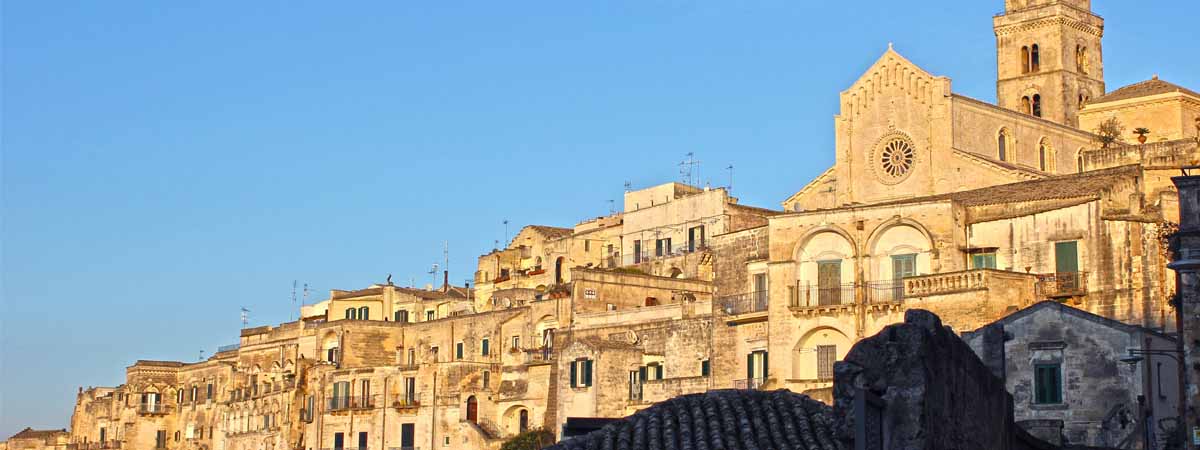

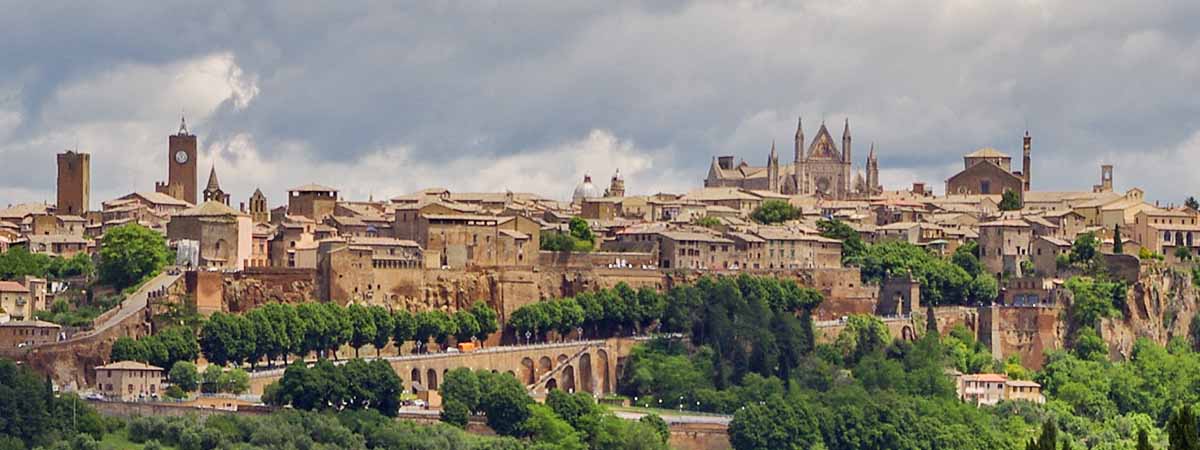
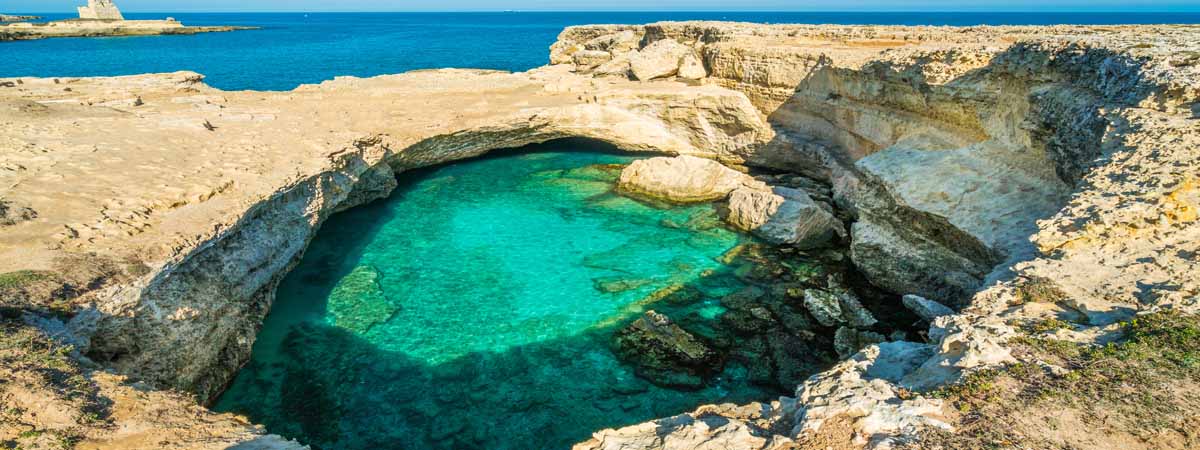
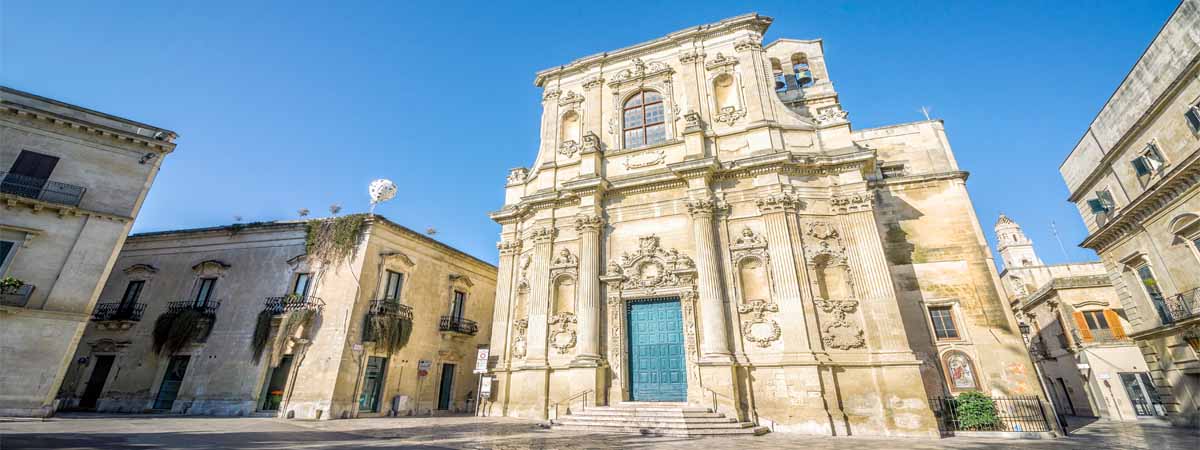

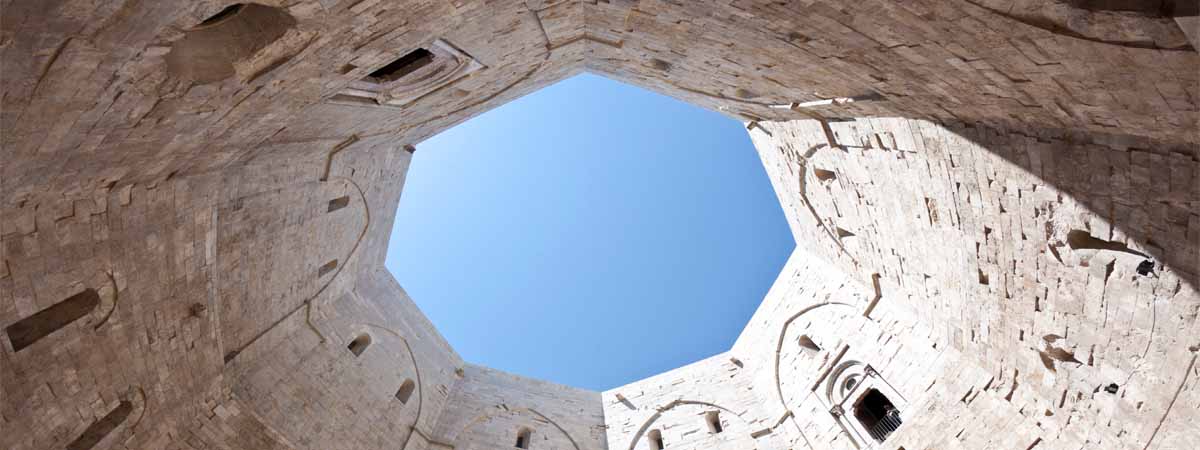
Travel Guides
[wudrelated include="1837"]
The Friuli Venezia Giulia Region of Italy
[wudrelated include="4233"]
The Cities of Friuli Venezia Giulia, Italy
[wudrelated include="4234"]
